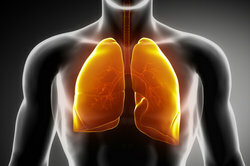How big are the lungs?
The lungs are vital organs. But very few know how big it is and what structure it has. Learn more about the human body.

Structure of the lungs
The lungs are an organ that is not only found in humans or mammals. Birds, reptiles, amphibians and even some fish also have lungs. In the following, however, the human organ will mainly be dealt with.
- The lungs are located in the chest area above the diaphragm. It extends roughly to the collarbone. This respiratory organ thus occupies a large place in the body.
- As in all mammals, the human lungs are divided into two lungs - the right and left lungs. Since the heart also needs space in the chest and is located in the left half of the body, the left lung is slightly smaller than the right.
- Cuts or Furrows in the lungs subdivide these in turn into so-called lung lobes. There are two lung lobes on the left in humans and three on the right.
- The lungs themselves do not contain any muscle tissue, so the half of the body is controlled by the diaphragm and the muscles of the ribs. The lungs themselves consist on the one hand of the air-conducting system - the bronchi - and on the other hand of the alveoli. These have a large surface. This is necessary so that the gas exchange can take place.
Anatomy: Lungs - their structure and function clearly explained
We breathe without really being aware of it. Breathing works without ...
How big is this organ?
- The size of the lungs naturally depends on the type and size of the lungs. A small animal will mostly have smaller lungs than a larger animal. It is also not possible to give a standard percentage in relation to body size, since the lungs of birds, for example, make up a significantly larger proportion of the body than mammals.
- Lifestyle can also have a significant impact on lung volume. There are even differences from person to person. Competitive athletes usually have larger lungs than unsportsmanlike people.
- The total capacity describes how much air fits into the lungs. On average, this size is around 5 liters. Even when you exhale, around 1.5 liters of air remain in the lungs. This is known as the residual volume. The difference is called vital capacity and can vary between 2 liters, for example in the elderly, and up to 10 liters in extreme athletes.
- Since the lungs are subdivided by the many small alveoli, there is a very large internal surface area of about 100 m² for this organ.
- The weight of the lungs is about 1.3 kg. In terms of volume, it is therefore quite light due to the high air inclusions.
How helpful do you find this article?


